Since 1997, drivers have enjoyed better fuel economy, lower running costs and unrivalled levels of comfort and refinement thanks to Toyota’s hybrid technology. Today, Toyota’s range of hybrid cars encompasses small hybrids like the Toyota Yaris Hybrid, family size cars like the Toyota Prius, Corolla and Toyota C-HR, even estates like the Corolla Hybrid Touring Sports. But have you ever wondered how hybrid cars work?
Read on to discover exactly what Toyota’s hybrid drive system is, how it works and how it benefits the environment and your wallet.
What is a hybrid?
Simply put, a ‘hybrid’ is a vehicle with two or more power sources. Most hybrid road cars use a normal internal combustion engine paired with an electric motor, but the way these work together means that there are several different kinds of hybrid setup.
Beginning with the original Prius, Toyota pioneered the full hybrid system that uses two separate powerplants – a battery-powered electric motor and petrol-driven combustion engine – which can work together to drive the vehicle or can each be used in isolation. It is the most popular hybrid system in the world, and has sold more than 15 million units since the Prius was launched in Japan in August 1997.
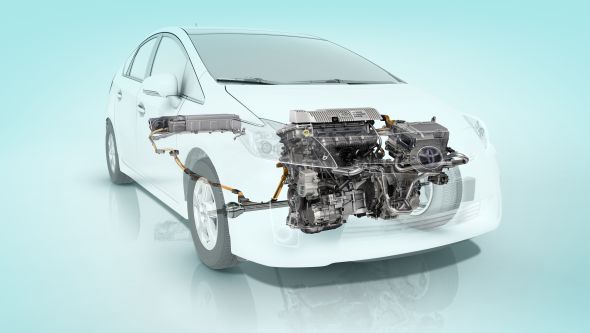
The second kind of hybrid is known as parallel. It uses a normal combustion engine as the main source of power, with an electric motor fitted between the engine and gearbox to provide assistance. This arrangement tends to be more restricted in its function than a full hybrid, and fitting an electric motor into a very small space also limits its power and EV (electric vehicle) range.
Lastly, the third hybrid variation is the series type. In this type of vehicle the electric motor provides all the drive. The normal combustion engine isn’t connected to the transmission, and instead works as a generator to power the electric motor. The main hurdle for a series hybrid is maintaining its efficiency once the battery power has been used up. For this reason, series hybrids are rare.
Toyota hybrid – how does the system work?
Toyota’s hybrid drive system consists of six primary components: petrol engine, electric motor, electric generator, power control unit, and a power split device that uses a special type of gearbox to smoothly distribute power from the engine, motor and generator.
It is a clever, fuel-saving technology that can seamlessly and automatically switch between electric power and conventional engine power. Capable of adapting to different driving conditions, our hybrid system intelligently controls the power coming from both sources and tells the car how to combine them for the greatest efficiency and performance.
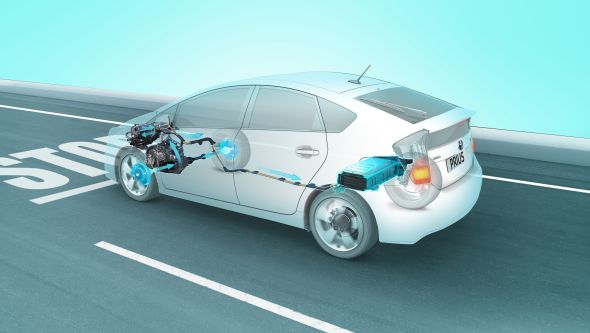
The system delivers true synergy between the two power sources. When the engine is running, it charges the battery via the generator; when driving conditions allow it, such as in slow-moving traffic, the generator can cut out the petrol engine and let the electric motor take over for zero-emissions travelling. The sophisticated engine management system can sense when the car is stopped and will switch off the engine to conserve power and cut emissions, automatically starting up again when needed.
The battery is kept well charged by the system, so a hybrid-powered Toyota won’t need to be plugged into a mains supply to be recharged.
However, Toyota does produce plug-in hybrid electric vehicles for people who can make use of its greater range of more than 30 miles in electric-only EV mode and cars which convert hydrogen into electricity. Read more about the different types of hybrid and electrified vehicle by clicking here.
How are the batteries charged?
Toyota’s hybrid system charges the battery in two ways. Firstly and as already mentioned, the petrol engine drives the generator to charge the battery. The second method is through regenerative braking, a system that puts braking energy to good use.
Every time you put your foot on the brake or lift off the accelerator, the system diverts energy back to the battery where it is, in effect, recycled. Instead of the energy being lost as heat or noise from the brakes, it is captured and then used to power the electric motor later. This is particularly efficient in stop-start traffic where the system recovers and stores a great deal of energy, making the car more efficient overall.
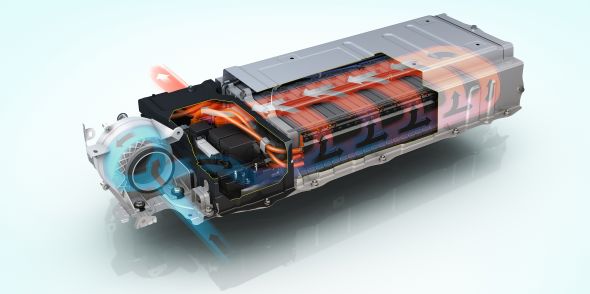
For a PHEV like the Prius Plug-in, the on-board battery can also be charged at home using the mains supply or at dedicated charging points along your journey, allowing the greater EV range of up to 30 miles.
How long do hybrid batteries last?
The batteries in Toyota’s hybrid vehicles are efficient, corrosion-resistant units designed to last, which is why Toyota’s standard battery warranty is five years or 100,000 miles and can be extended up to 15 years with no limit on total mileage – read more about this here.
The batteries are substantial units that have to store sufficient voltage to power the car with no assistance from the petrol engine. It’s true that their production does have a small, additional environmental impact, but this is more than offset by the environmental benefits of driving a hybrid car. In fact, we’ve dispelled that hybrid myth, along with others, in this post.
Toyota is also keen to recycle the batteries from its hybrid cars, which can be remanufactured to make new batteries or repurposed into other forms of stationary energy storage – this can be arranged through your Toyota dealer. We already recover over 90% of hybrid batteries from our vehicles, and are targeting a 100% recovery rate.
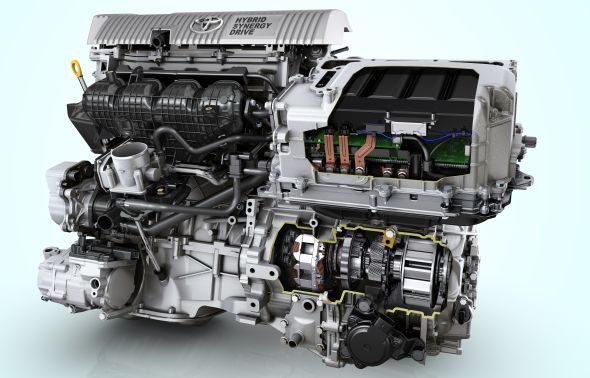
Is the engine different to that of a normal car?
In short, yes. The internal combustion engine used in a Toyota hybrid uses a slightly different engine cycle than the conventional Otto-type four-stroke cycle. Called the Atkinson cycle, this modified four-stroke cycle produces less heat and is therefore more efficient.
By cooling the internal combustion chamber using recirculated exhaust gases, it avoids a problem faced by engines with traditional cycles: injecting more fuel than necessary to reduce combustion temperatures and prevent the catalytic converters from overheating. The traditional remedy works, but uses more fuel in the process. However, Toyota’s solution is more fuel-efficient and is very reliable.
A more in-depth analysis of Toyota’s use of the Atkinson cycle can be read here.
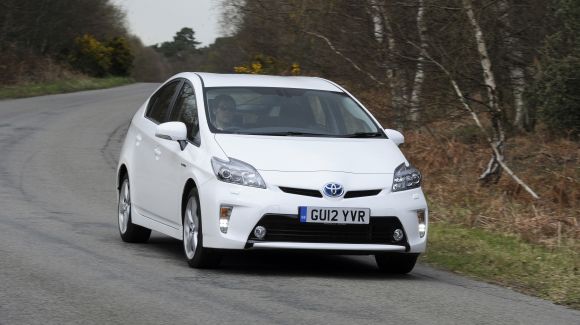
Do I have to drive differently to make the most of hybrid technology?
Not at all. Because Toyota has made the hybrid system fully automatic, it will optimise its operation and minimise fuel use for each driver. You can sit back and enjoy the drive!
You can read more about the experience of driving a Toyota hybrid by reading this article, in which motoring journalist Tim Dickson takes a Corolla Hybrid for a spin.
There are also some general tips, many of which apply to maximising the fuel economy of hybrid and non-hybrid cars alike, at this link.
To find out more about our complete range of hybrid vehicles, click here.
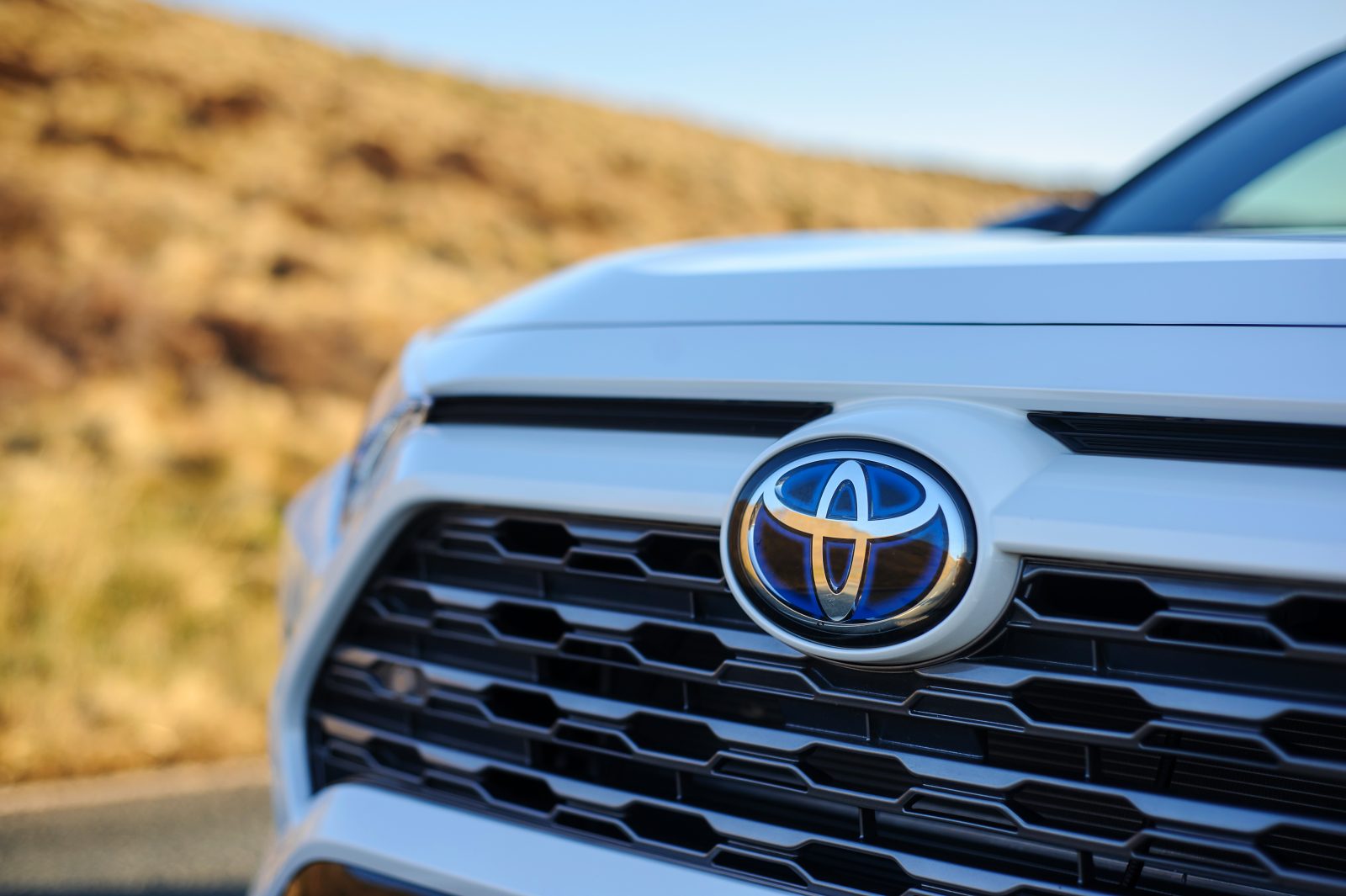
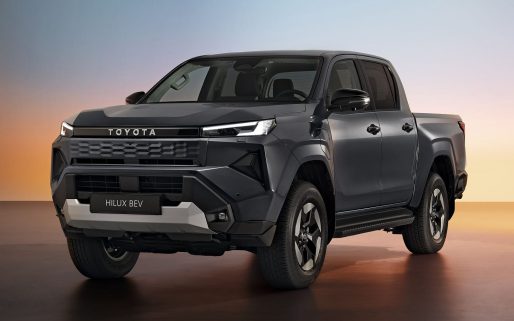
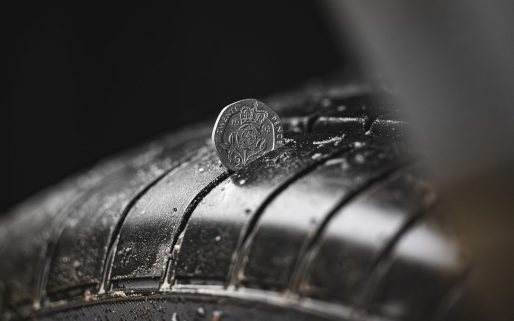

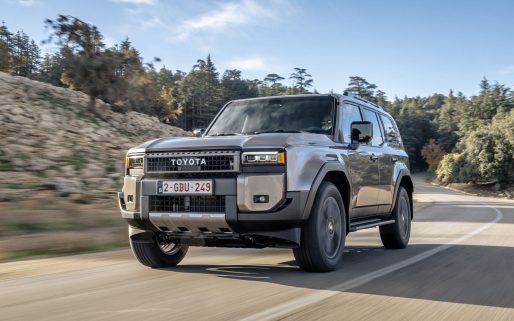
What Euro Engine size is Toyota Prius vvt I 1.8 Hybrid Electric .first registration of the car March 2014.
Hi Alam,
Thanks for getting in touch. This vehicle complies with EURO V emissions regulations. Thanks.
I’ve had an Auris (which I liked a lot) since 2009 and I exchanged it for an Auris Hybrid a month ago.
I love this version of the Auris. Being fully automatic it’s a dream to drive, it’s more pokey than the 1.6 litre version, it’s glued to the road and crucially it is so economical – getting 60-odd miles per gallon and one one occasion 68 mpg; and it’s rising as the petrol engine runs-in.
I only do 7,000 miles a year so I need to fill up with petrol just once a month. It’s motoring for free!
Hi John,
Thanks for getting in touch. We’re glad to hear how much you love your Auris Hybrid and we wish you many more happy miles ahead. Thanks.
My auris15 plate gets poor mileage driving slow no a.c no power nothing its not good
I have just bought the Auris Estate Hybrid. For the first week I loved it. Was on 72mpg and over 60mpg locally. I have always bought cars for their fuel efficiency (having had LPGs for last 15 years) and driven efficiently. I find the fuel economy has been similar to that of my LPGs. The big benefit of LPG was that I could chose when to run on Petrol or LPG. Such a button on this car would make it very good. Similar to Jean’s comment above, I know my commute and know exactly where and when my battery needs to be charged. Yet the car is trying to charge the battery using petrol as soon as I start the car when it really doesn’t need to as I know I am about to descend a massive hill.
This last week, even with the weather actually being warmer than last week, the petrol engine has started kicking in within 5 seconds of hitting the Power button.
I would understand if it just needed to lubricate the engine, but it seems to be putting all its energy (fuel) into charging the (already full) battery. Yet, I always get home with the battery as fully charged as it can be and live at the top of a hill, so should be able to get to the main road without using any fuel.Yet for the last week the petrol engine has not only kicked in, but seems to be spending all its fuel on charging the already full battery and won’t go above like 15mpg all the way down the hill!?!
This is extremely frustrating and surely this cannot be right?! It even starts the petrol engine when I’m doing the school run. So I will have been driving for 20 minutes, parked for just 10 minutes, start the car again and the petrol engine kicks in! So frustrating. This would be an ideal time and location, to just be slowly driving along on battery only. What is going on?
To pre-empt any obvious answers… no I do not use A/C nor heating. I am not the variant. First week, car drove as I would hope. 2nd week, manifesting the problems described above. It is only 2 years old and only just done 14k and had a service before purchase.
Many thanks in advance.
Hi Gavin,
Thanks for getting in touch. We have spoken to our Technical Team and they state that on a Hybrid vehicle, the engine may run for the following reasons:
1. If the HV battery State of Charge becomes below a predetermined value, the engine will run in order to run one of the electric motors (incorporated in the transaxle) and charge the HV battery.
2. If the coolant temperature is below a predetermined value, the engine will run in order to keep the temperature of the catalytic converter at the correct levels – as the catalytic converter will only work efficiently above a certain temperature.
3. If the vehicle’s heating system is being used (not necessarily in conjunction with the A/C), the engine will run in order to warm up the coolant so that the vehicle cabin can also be warmed up efficiently.
Hope this helps.
First of all I have a 2017 Toyota Prius and I love the vehicle. I’ve been taking freeway to work and the surface streets back (instead of freeways PHX-USA) and have been getting 60+ MPG. Seriously, took picture did 602 miles on 10.04 gallons of fuel. Made it to Vegas and back on one tank 614 miles. I don’t recommend it, I was real nervous going up the last hill to Kingman. Does Toyota have a general electric motor blog?
Hi Philip,
Thanks for getting in touch.
What an impressive journey! Unfortunately, Toyota GB does not have a general electric motor blog.
Thanks.
Hi. Just wondering why the RAV4 hybrid is not in the list of hybrid s. . Is it an older, less efficient hybrid that you disown ?? Just ordered one. . So a bit concerned. ! !
Hi Angus,
Thanks for getting in touch.
Thank you for pointing this out, this blog post was written before the RAV4 Hybrid was announced, therefore it has not been updated.
We are sorry about this, we are currently updating this article now.
We hope you enjoy your new RAV4 Hybrid!
Thanks.
Hye…..
I have aqua 2015 S model. I have driven it on weekend and it was a long drive of about 200+ km. However my EV battery showed good charge of about 9/10. As soon as i was in local drive in low gear, vihicle was working fine on EV mode but battery terminal drops to 3/10. It used to be quite sudden, but no issue otherwise. Can someone suggest what is the problem or is it ok???
Hi Nasir,
Thanks for getting in touch.
We would suggest for you to contact your local Toyota centre regarding this, as they will be able to assist you further. You can find your local centre via this link:
https://www.toyota.co.uk/find-your-dealer.
Thanks.
I have recently bought a Toyota Yaris Icon Hybrid, can anyone tell me if it is worthwhile using the eco mode and when it is best to use it?
Hi Marie,
Thanks for getting in touch. ECO mode is suitable for improving the fuel economy, because the torque corresponding to the accelerator pedal depression amount can be generated more smoothly than it is in normal conditions and the operation of the air conditioning system (heating/cooling) will be minimized.
Eco drive mode controls the heating/cooling operations and fan speed of the air conditioning system to enhance fuel efficiency. To improve air conditioning performance, adjust the temperature setting or fan speed, or turn off Eco drive mode.
We hope this helps.